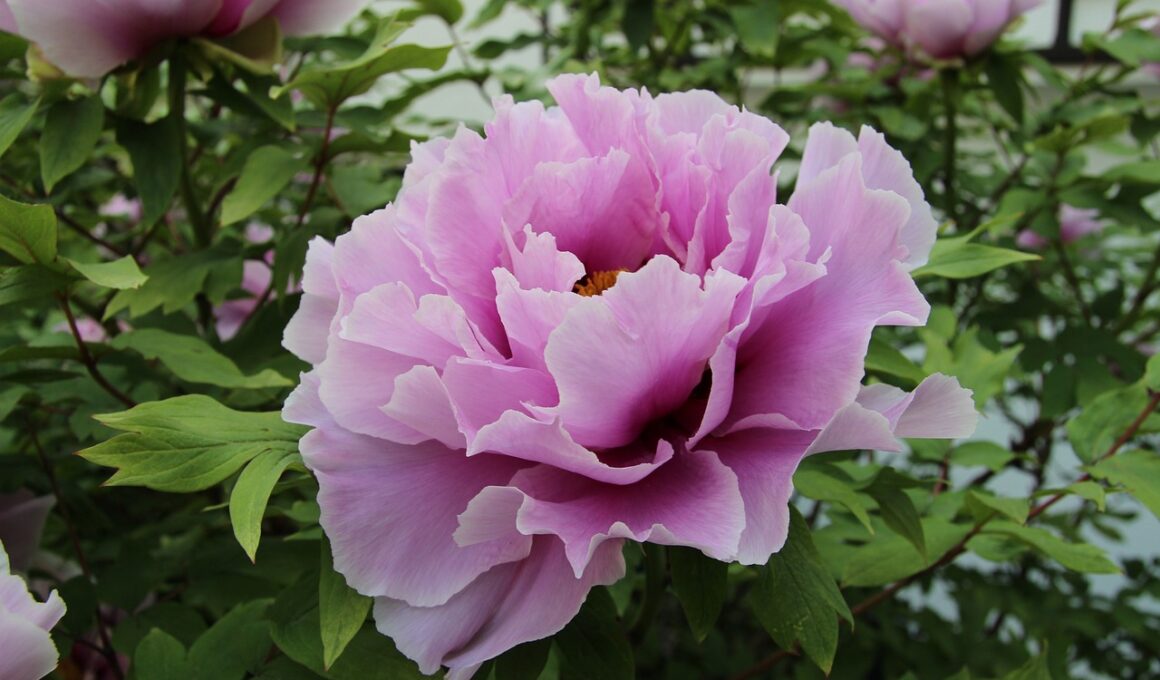Do you have peonies in your garden? If so, you may be wondering whether or not you should cut them back every year. The debate over this topic is ongoing, with some gardeners swearing by the practice and others adamantly opposed.
In this article, we will explore the benefits and drawbacks of cutting back peonies, as well as special considerations to keep in mind, so that you can make an informed decision for your own garden.
Peonies are a beloved flower for their lush, showy blooms and delightful fragrance. As a gardener, you want to ensure that your peonies thrive and continue to produce beautiful flowers year after year. But with conflicting opinions on whether or not to cut them back, it can be difficult to know what to do.
By understanding the reasons for cutting back peonies, as well as the potential downsides, you can make an informed decision that will keep your garden safe and beautiful.
The Debate Over Cutting Back Peonies
The ongoing debate regarding whether or not to trim these beautiful flowers regularly remains a topic of discussion. Some gardeners swear by cutting back peonies every year, while others believe that it’s unnecessary. Ultimately, the decision to prune or not to prune comes down to personal preference and the condition of the plant.
Pruning techniques vary depending on the type of peony and the desired outcome. Deadheading, or removing spent blooms, can encourage the plant to produce more flowers. Cutting back the foliage in the fall can help prevent disease and prepare the plant for winter. However, some gardeners prefer to leave the foliage intact over the winter to protect the plant from cold temperatures.
Seasonal timing is also an important factor to consider when deciding whether or not to prune peonies. Spring-blooming varieties should be pruned immediately after blooming, while summer-blooming varieties should be trimmed back in the fall. Regardless of when you choose to prune, be sure to use clean, sharp tools to prevent damage to the plant.
With proper care and maintenance, peonies can thrive for many years without the need for regular pruning.
Benefits of Cutting Back Peonies
If you want to encourage new growth and increase the size of your peony blooms, cutting back your peonies every year is highly recommended.
Additionally, cutting back your peonies can also help control diseases that may affect the plant.
By taking the time to prune your peonies, you can ensure that they’ll thrive and produce beautiful, healthy blooms year after year.
Encourages New Growth
Encourage new growth in your peonies by giving them a fresh start each season. Cutting back the plant every year promotes growth by removing dead or damaged stems and encouraging new ones to grow. You can also use this as an opportunity to shape the plant and remove any diseased or infected parts.
Pruning techniques vary depending on the type of peony you have, but generally, you should cut the stem down to just above the first set of leaves. This will encourage the plant to produce more stems and flowers. Don’t be afraid to cut back the plant aggressively if it’s overgrown or has become too woody.
With a little care and attention, your peonies will thrive and produce beautiful blooms year after year.
Helps Control Diseases
Pruning annually promotes healthier growth and helps prevent the spread of diseases in your peonies. By removing dead or diseased wood, you can prevent the spread of diseases like botrytis or leaf spot. Additionally, pruning encourages new growth that’s more resistant to diseases and pests.
To ensure disease prevention and promote healthy growth, follow these maintenance techniques when pruning your peonies:
-
Cut back dead stems and foliage to the ground in the fall or early spring.
-
Sterilize your pruning tools with rubbing alcohol or bleach before and after use to prevent the spread of diseases.
-
Leave at least 3-5 healthy leaf buds on each stem to promote new growth.
By following these simple steps, you can help control diseases and promote the overall health of your peonies. Remember, prevention’s key when it comes to maintaining a healthy garden.
Increases Bloom Size
Get ready to experience bigger, more beautiful blooms with just a little annual maintenance. By cutting back your peonies every year, you can increase their bloom size and density. This is because the energy that would have gone into producing more leaves and stems is instead directed towards producing larger and more abundant flowers.
To further enhance the effectiveness of this pruning technique, it is important to use proper pruning techniques. This includes cutting back the stems to just above a healthy set of leaves, and removing any dead or diseased growth. By doing so, you not only encourage larger blooms, but also help prevent the spread of diseases that can harm your peonies. So, grab your gardening shears and get ready to enjoy a stunning display of peony blooms with just a little annual maintenance.
| Bloom Density | Pruning Techniques | |||
|---|---|---|---|---|
| More abundant | Cut back stems to just above healthy leaves | |||
| Larger | Remove dead or diseased growth | |||
| Healthier | Directs energy towards producing larger blooms | Promotes air circulation | Helps prevent fungal diseases |
Drawbacks of Cutting Back Peonies
If you trim your peonies too much, you might be sacrificing the beauty and fullness of your blooms. While cutting back peonies can help promote healthy growth and larger blooms, there are also some drawbacks to consider.
Here are a few reasons why you might want to think twice before pruning your peonies too aggressively:
-
Reduced bloom quantity: If you cut back your peonies too much, you may end up with fewer blooms overall. Peonies rely on the previous year’s growth to produce flowers, so cutting back too much can limit their ability to bloom. If you’re looking for a lot of flowers, it’s best to take a more conservative approach to pruning.
-
Delayed blooming: Peonies that are pruned too heavily may also take longer to bloom. This is because the plant needs time to recover from the pruning process and put its energy into producing new growth. If you’re eager to see your peonies in full bloom as soon as possible, you may want to avoid cutting back too much.
-
Increased susceptibility to disease: Peonies that are cut back too much may also be more prone to disease. This is because cutting back leaves the plant vulnerable to pests and fungal infections. If you’re concerned about the health of your peonies, you may want to explore alternative methods of pruning that are less aggressive.
Overall, while cutting back peonies can be beneficial in some ways, it’s important to consider the potential drawbacks as well. If you’re unsure about the best pruning techniques for your plants, it’s always a good idea to do some research or consult with a gardening expert.
By taking a careful and considered approach to pruning, you can help ensure that your peonies stay healthy and beautiful for years to come.
Special Considerations
You’ll love learning about special considerations for your beloved peonies in this section.
When it comes to pruning techniques for peonies, it’s important to remember that not all peonies require the same level of pruning. While some peonies may benefit from a light pruning to encourage new growth, others may require a more aggressive pruning to maintain their health.
One special consideration to keep in mind when pruning your peonies is the weather conditions. If you live in an area with harsh winters, it may be necessary to prune your peonies more aggressively to protect them from frost damage. On the other hand, if you live in a warmer climate, you may need to prune your peonies less frequently to allow them to thrive in the milder weather.
Overall, it’s important to take the time to learn about your specific type of peony and its individual pruning needs. By doing so, you can ensure that your peonies remain healthy and beautiful year after year.
So, whether you’re an experienced gardener or just starting out, don’t hesitate to do your research and give your peonies the care they deserve.
Making the Decision
Now that you know about the special considerations when it comes to peonies, it’s time to make the decision of whether or not to cut them back every year. This decision will ultimately depend on your personal preferences and gardening goals.
If you want your peonies to produce larger blooms, then you may want to consider cutting them back every year. Pruning techniques can help stimulate growth and encourage bigger flowers. However, if you prefer a more natural look for your garden, then you can skip the yearly pruning altogether.
Additionally, seasonal timing is important when it comes to pruning your peonies. It’s best to wait until late fall or early winter, after the foliage has died back, to cut them back. This allows the plant to store up energy for the next growing season.
Overall, the decision to cut back your peonies every year is up to you and what you want for your garden.
Frequently Asked Questions
How often should peonies be cut back?
To keep your peonies healthy and blooming, it’s important to know when and how to prune them.
Pruning techniques vary depending on the type of peony, but generally you should cut back the stems to about 2-3 inches above the ground in the fall or early spring.
Optimal timing for pruning is after the first frost in the fall or before new growth appears in the spring. This will help promote new growth and larger blooms.
Be sure to also remove any dead or diseased foliage to prevent the spread of disease.
With the right pruning techniques and timing, your peonies will flourish year after year.
Do you need to cut back peonies if they are still producing flowers?
If your peonies are still producing flowers, you don’t necessarily need to cut them back just yet. Pruning alternatives include deadheading the spent blooms and removing any damaged or diseased foliage.
Leaving peonies uncut for a season can also have benefits, such as promoting stronger root development and potentially increasing the number of blooms in the following season. However, if your peonies are overcrowded or not producing as many blooms as they used to, cutting them back may be necessary to rejuvenate the plant.
Ultimately, the decision to cut back your peonies should be based on the specific needs of your individual plants.
Can cutting back peonies improve their overall health?
Pruning techniques are essential for maintaining the health and beauty of your peonies. Cutting back your peonies every year can enhance their overall health, promoting new growth and fuller blooms.
By pruning away dead or diseased foliage, you can prevent the spread of harmful pathogens and encourage the plant to focus its energy on healthy growth. Regular pruning can also help to shape your peonies, promoting a more symmetrical appearance and preventing overcrowding.
Overall, the benefits of pruning far outweigh any potential downsides, so don’t hesitate to incorporate this important technique into your peony maintenance routine.
Will cutting back peonies affect their blooming season?
If you want to ensure that your peonies bloom beautifully every year, pruning techniques are essential.
Timing of pruning is important, as cutting back your peonies at the wrong time can damage the plant and delay or even prevent blooming.
To encourage healthy growth and plenty of blooms, it’s recommended to prune your peonies in the fall, after the foliage has died back. This allows the plant to store energy for the following year’s growth.
However, if you missed the fall window, you can also prune in the spring, but be sure to do so before the new growth emerges.
By properly pruning your peonies, you can help them thrive and enjoy a stunning blooming season year after year.
Should you cut back peonies if they are planted in a container?
If you have peonies planted in a container, it’s important to know the right pruning techniques to keep them healthy and blooming.
Unlike peonies planted in a garden bed, those in a container have limited space for their roots to grow. As a result, you should trim back the foliage and deadhead the flowers regularly to prevent the plant from becoming too crowded.
Pruning should be done in the fall after the plant has finished blooming for the season. Container gardening can be a great way to grow peonies, but it requires a bit more attention and care to ensure they thrive.
Conclusion
So, should you cut back your peonies every year? The answer depends on your personal preferences and gardening style.
If you want to encourage larger blooms and prevent disease, cutting back your peonies in the fall may be a good idea. On the other hand, if you prefer a more natural look and don’t mind smaller blooms, you can skip the cutting back.
It’s important to consider the potential benefits and drawbacks of cutting back peonies before making a decision. Ultimately, the choice is yours.
With a little research and experimentation, you can find the best approach for your peonies and create a beautiful, thriving garden.
Happy gardening!









